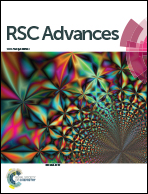Theoretical investigation of the effects of various substituents on the large energy gap between triplet excited-states of anthracene†
Abstract
The utilization of excitons is key to the effectiveness of organic electroluminescent materials. Recently, HLCT state materials were shown to use triplet excitons to achieve ultra-high electroluminescence efficiency. The large energy gap between triplet states (ΔET1–T2) is key for these materials. In the current computational work, we used the anthracene structure with its large ΔET1–T2 as a template, and to this skeleton we connected various substituents at different sites to explore the effects of these substituents on the excited states of the full molecule. We focused on the change of the ΔET1–T2. Based on our analysis, we concluded the strongly electron-withdrawing substituents and those groups containing oxygen atoms to have the greater influence on the excited state, and to yield anthracene derivatives no longer having the large triplet energy difference characteristic of the unsubstituted anthracene molecule.



 Please wait while we load your content...
Please wait while we load your content...